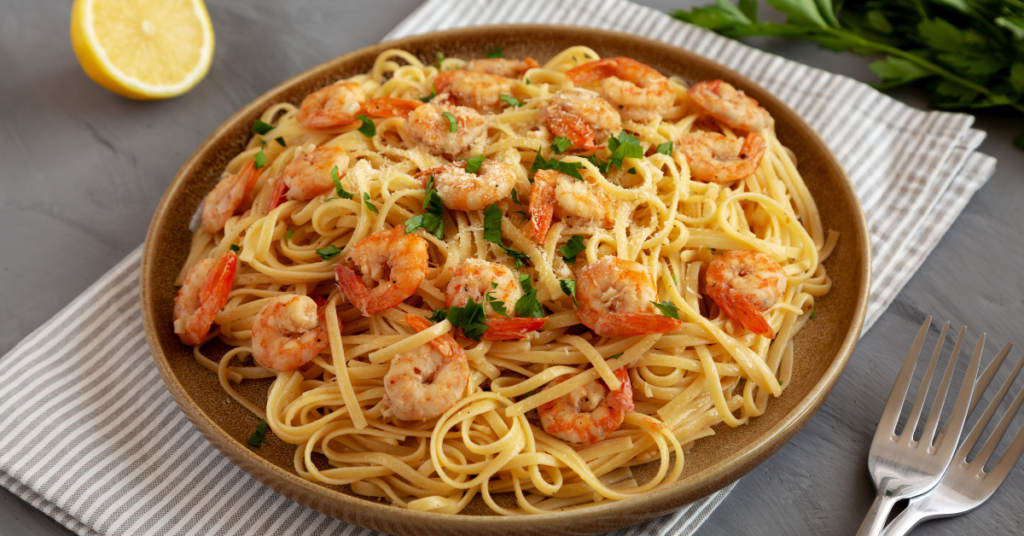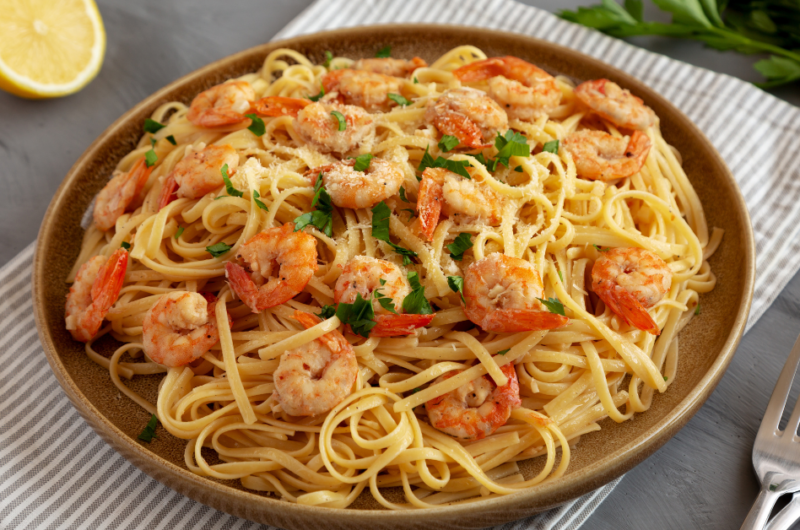If you want an easy, elegant, and delicious dinner, garlic butter shrimp pasta is your answer. This dish features juicy shrimp in a lush garlic butter sauce and al dente pasta, which is comforting but elevated. This recipe allows you to create restaurant-quality flavors, whether preparing for a special event or a casual weeknight supper.
This one is prepared with a handful of tasty components that produce great harmony, including shrimp, olive oil, butter, fresh garlic, and seasonings. Together, these ingredients make for a crowd-pleaser and all the right reasons. The best thing is you can prepare this delectable meal in 30 minutes or less! I promise you that this recipe will be a staple in your weeknight rotation once you make it.
How to Choose the Best Shrimp
Your choice of shrimp can significantly alter the dish’s flavour and consistency. Here’s how to make an informed decision.
Fresh or Frozen
- Fresh Shrimp: Fresh shrimp is best, but use what you can. Seek shrimp with a clean, ocean-like smell and a firm texture.
- Frozen Shrimp: Thawed correctly, it is just as good as fresh. Select individually quick frozen (IQF) to retain freshness.
- What to Buy: Choose ”wild-caught” shrimp, which are fresher and more sustainable than farm-raised shrimp.
Size Matters
The count per pound sells shrimp, and size influences cooking time and texture.
- Large Shrimp: Large Shrimp (16-20 per pound) are the key to this dish. Their meaty, satisfying bite works well with pasta.
- No Tiny Shrimp: Small shrimp tend to overcook quickly and become lost in the dish.
Prepped and Ready
- Peeled and Deveined: Naked, Cleaned, and Ready to Peel It Yourself.
- Tail-On or Tail-Off: Shrimp that still have the tails on look nice for presentation but can be less convenient for dinner. Choose tail-off for a no-fuss experience.
Spotting Quality
- Appearance: Flesh should be translucent with a slight sheen. Steer clear of shrimp with black spots or a strong fishy smell.
- Packaging: For frozen shrimp, ensure the bag is intact and free of ice crystals, and check its expiration date.
If you pick the best shrimp, you already have the makings of a flavorful, restaurant-quality garlic butter shrimp paste.
How to Choose the Right Pasta for This Recipe
After all, the pasta you use can elevate the dish by enhancing the flavours and textures of the shrimp and sauce. Here’s how to choose the right pasta.
Classic Choices
- Spaghetti: A classic (always ready) option that makes a versatile base for the garlic butter sauce.
- Linguine or Fettuccine: Their slightly thicker, flat shape clings to the creamy sauce, offering a luxurious bite.
Unique Textures
- Penne or Rigatoni: The tubular shapes are great for trapping pieces of shrimp and sauce, providing a heartier texture.
- Angel Hair: This delicate and thin pasta is great for a lighter, more elegant rendition of the dish.
Cooking Tips for Pasta Types
- Thicker Pastas (Fettuccine, Rigatoni) may also require a few extra seconds of boiling. Consult package instructions for al dente perfection.
- Delicate Pastas (e.g., angel hair): Use a short cooking time and pay close attention to avoid going too far.
Pro Tip: Salt Your Water Well
- Adding salt to the boiling water and seasoning the pasta improves its performance with the rich garlic butter sauce. Here is a great price to aim for: sea-level salinity!
You can adjust the type of pasta that best suits your garlic butter shrimp pasta, from light and delicate to hearty and filling.
Ingredients
For the Shrimp:
- One pound (450 grams) of large, peeled and deveined shrimp
- 2 tbsp unsalted butter
- 4 cloves garlic, minced
- 1 tbsp olive oil
- 1 tsp paprika
- Salt and pepper to taste
For the Pasta:
- 8 oz (225g) spaghetti (or pasta of choice)
- 2 tbsp unsalted butter
- 1 tbsp olive oil
- 4 cloves garlic, minced
- ½ cup chicken broth (or white wine for added depth)
- One teaspoon of red pepper flakes, if desired, for spiciness
- Juice of 1 lemon
- ¼ cup grated Parmesan cheese
- 2 tbsp fresh parsley, chopped
Instructions
Prepare the Pasta
- Boil a large pot of salted water.
- As directed on the package, boil a large pot of water over high heat and cook the pasta until al dente. After draining, save ½ cup of pasta water.
Cook the Shrimp
- Fast heat two tablespoons of olive oil and butter on medium heat.
- Cook the minced garlic for one minute or until it becomes aromatic.
- Add the shrimp, seasoning with paprika, salt, and pepper, and sauté for 2-3 minutes on each side, until pink and cooked.
- Take the shrimp out and set aside.
Make the Garlic Butter Sauce
- Add the extra butter and olive oil to the same pan.
- Add minced garlic and sauté until fragrant, 1 minute.
- Add chicken broth (or white wine) and simmer for 2-3 minutes to reduce a bit.
- Add red pepper flakes, lemon juice, and Parmesan. Mix until well combined.
Combine the Dish
- In the skillet, combine the cooked pasta with the water set aside. Toss the pasta to propagate the sauce correctly.
- After food preparation, transfer the seafood to the skillet and mix thoroughly.
- Sprinkle with fresh parsley and more Parmesan, if desired.
The Secret to the Perfect Garlic Butter Sauce
And that garlic butter sauce is the center of garlic butter shrimp pasta, as it adds richness, aroma, and balance to each dinner. Here’s how to nail it every time:
Butter and Olive Oil Combo
- Why It Works: Mixing butter with olive oil gives you a flavorful, rich base and prevents the butter from burning.
- Ratio: Use a 2:1 ratio of butter to olive oil for a nice balance of richness and smooth texture.
Garlic Preparation
- Fresh Is Best: Use fresh-minced garlic for the boldest, liveliest flavor. Avoid pre-minced or jarred garlic, as it can taste muted or sour.
- How to Cook the Garlic: Add the garlic and cook for around a minute over a medium-high flame, stirring until golden. Overcooked garlic may turn bitter.
Building Flavor Layers
- Deglazing the Pan: When shrimp is cooked, scrape up any delicious, brown bits left in the skillet by adding chicken broth or white wine.
- Simmering: After you add the sauce, give it time to simmer briefly so the flavors can meld. It also reduces the liquid to an intense taste.
It balances acidity with rich flavors.
- Lemon Juice: Fresh lemon juice cutting through the butter’s richness brightens the sauce.
- Optional Add-Ins: A splash of heavy cream for richness and a teaspoon of Dijon mustard for brightness.
Enhancing with Seasonings
- Red Pepper Flakes: A dash subtly adds heat to balance the garlic and shrimp. Adjust to taste.
- Parmesan Cheese: Mix in freshly grated Parmesan for extra depth and umami.
Finishing Touch
- Fresh Herbs: Add some chopped parsley or basil—birds with lovely aromatic freshness.
- Consistency tweaks: Add the reserved pasta water until you reach your desired sauce thickness—this perfectly binds the sauce to the pasta.
With these tips, your garlic butter sauce will do the trick, bringing bold, well-balanced flavor to the entire dish; after that, you’ll have people begging for seconds.
Cooking Methods to Ensure Perfect Shrimp
Perfectly cooked shrimp is succulent , juicy, and the star of garlic butter shrimp pasta. Here’s how to nail them perfectly:
Allow Shrimp to Come to Room Temperature
- Why It Matters: They may not be evenly cooked if you cook cold shrimp. Let them sit for 10-15 minutes before cooking (at room temperature).
Pat Shrimp Dry
- A Crucial Step to a Great Sear: Pat the surface dry with paper towels. What does this have to do with shrimp? Dry shrimp get a better sear and develop a gorgeous golden crust.
Season Simply but Well
- Before Cooking: Add olive oil to the prawns and toss salt, pepper, and seasonings (such as cayenne or paprika) before cooking.
Use Medium-High Heat
- Why It Matters: A medium-high heat provides a quick sear that locks in juices while building a slightly crisp surface.
Avoid Overcrowding the Pan
- Tip: If your shrimp don’t fit in one layer in a pan, cook them in batches; they need space around them to cook evenly. Overcrowded shrimp can steam instead of brown.
Cook Just Until Pink
- Timing: Shrimp usually require 2-3 minutes of cooking per side. They should be flipped as soon as they turn pink and opaque.
- The Visual Clue is the C-shape in shrimp that someone cooked. If shrimp are overcooked, they curl tightly into an O with rubbery edges.
Remove from Heat Promptly
- Carryover Cooking: Shrimp cook a little bit once you remove them from the pan. Carefully transfer them to a plate to prevent overcooking.
Deglaze the Pan
- Enhance Flavor: After the shrimp are cooked, use wine or chicken stock to glaze the pan, saving the mouthwatering bits for the sauce.
Use these tricks, and your shrimp will always be perfectly cooked, tender, and flavor-packed—the real star of your garlic butter shrimp pasta.
Tips for the Best Garlic Butter Shrimp Pasta
Use Fresh Ingredients: Fresh shrimp, garlic, and herbs genuinely make a difference in flavor.
Overcooked shrimp: They can get rubbery. Cook just until pink.
Adjust Spice Levels: If you like milder pasta, skip the red pepper flakes. For more heat, add extra.
Save the Pasta Water: It’s starchy and helps bind the sauce to the pasta.
The Role of Fresh Herbs in Garlic Butter Shrimp Pasta
Herbs aren’t just something pretty to garnish with; they add layers of freshness and complexity.
- Parsley: An evergreen option that brightens up and counteracts the sauce’s richness.
- Basil: Adds mild, aromatic, slightly sweet flavor that works well with garlic.
- Chives: Add a mild oniony brightness to the dish.
- Thyme or Oregano: Great for Mediterranean variations on the recipe.
What to Serve with Garlic Butter Shrimp Pasta
To elevate your meal, consider pairing the pasta with the following sides:
Fresh Salads:
- This beautiful match is paired with a simple arugula salad and lemon vinaigrette.
- A Caesar salad provides a creamy counterpoint to the garlicky pasta.
Garlic Bread:
- This toasted bread with garlic butter and herbs is good for mopping up any leftover sauce.
Roasted Vegetables:
- The great sides are roasted asparagus, broccoli, or Brussels sprouts with olive oil and Parmesan .
Soup Starters:
- For a full meal, serve alongside a light soup, such as minestrone or a simple tomato basil soup.
Enhancing the Flavor Profile with Camouflage
Essential salt and pepper get the job done, but here are some for extra depth:
- Paprika: Sweet or smoked paprika gives the shrimp a warm flavor and color.
- Cayenne Pepper: Adds a ZING of spice to the flavor.
- Italian seasoning: A mixture of oregano, thyme, and basil for some Italian flair.
- Lemon Zest: Brings a tangy brightness without any extra acid.
Enhancing the Presentation
Not only is this dish delicious, but it is also a real looker. Make it restaurant-worthy by:
- Using Fresh Herbs: For color and freshness, add a sprinkle of parsley, basil, or chives.
- Twisting the Pasta: Use a carving fork to twirl the pasta nicely around the plate for an elegant touch.
- Finishing Touches: Before serving, toss with a few lemon wedges and some Parmesan cheese.
Garlic Butter Shrimp Pasta With a Global Twist
Though this recipe is grounded in Italy, you can globalize it:
- Asian-Inspired:
- Try soy sauce, sesame oil, and ginger in the sauce for an umami-rich twist.
- Top with scallions and sesame seeds.
- Mediterranean Touch:
- Remove and fold in sun-dried tomatoes and olives and crumbled feta cheese.
- Replace the parsley with oregano and thyme.
- Cajun Style:
- Add Cajun seasoning for a spicy, smoky taste.
- For a heartier dish, add andouille sausage and bell peppers.
- Creamy French Flair:
- The right amount of richness comes using a dash of white wine and a splash of heavy cream.
Customizing for Special Diets
This recipe is easily modified for different dietary preferences:
- Gluten-Free: Substitute gluten-free pasta. Make sure the broth is gluten-free, too.
- Keto-Friendly: Swap out pasta for zucchini noodles or spaghetti squash.
- Dairy-Free: Exchange the butter for vegan butter or extra virgin olive oil.
- Low-Sodium: Use unsalted butter, and use homemade low-sodium broth.
Experimenting with Cheese Pairings
Parmesan is the traditional go-to, but other cheeses can provide interesting flavor profiles:
- Pecorino Romano: A sharper, saltier version of Parmesan.
- Asiago: Provides a nutty, creamy note.
- Mozzarella: You’ll want shredded mozzarella for the peak gooey, melty end.
- Goat Cheese: This gives you a tangy zip if you want a bolder taste.
Creating a Seafood Feast
Make this recipe the star of a seafood-themed dinner:
- Additions to the Dish: Scallops, mussels, or crab meat could all work in this dish alongside the shrimp.
- Side Dishes: Pair with clam chowder or a seafood bisque for a coastal vibe.
- Drinks: Pair it with a refreshing white wine spritz or citrus-infused sparkling water.
How to Plate Garlic Butter Shrimp Pasta Like a Pro
Turn your homemade dish into a restaurant-worthy presentation:
- Use tongs to twine pasta into a little mound on the plate.
- Top pasta with shrimp, distributing evenly for a nice presentation.
- Douse the top with extra sauce for shine and taste.
- Serve topped with freshly chopped parsley, grated Parmesan, and a wedge of lemon on the side.
Making It a One-Pot Dish
To make this a one-pot recipe, save time and cut cleanup:
- Use a Dutch oven or a large saucepan to cook the shrimp.
- Remove the shrimp, then make the garlic butter sauce in the same pot.
- Cook the pasta right in the sauce, adding broth or water for absorption.
- You toss it all together and serve from the same pot.
Making It Meal Prep Friendly
This garlic butter shrimp pasta is surprisingly meal-prep friendly. Here’s how:
- Batch Cooking:
- Double the recipe and freeze portions in airtight containers.
- Avoid soggy pasta and shrimp by keeping them apart.
- Storage Tips:
- Refrigerate for up to 3 days.
- For extended storage, freeze shrimp; thaw and reheat gently to retain texture.
- Reheating Suggestions:
- Add a splash of shares or olive oil to return the sauce, and prepare in the skillet over a low flame.
Nutritional Benefits of Garlic Butter Shrimp Pasta
Though this dish seems indulgent, it has surprising health benefits:
- Rich in Protein: Shrimp is a source of lean protein that can help repair muscles and keep us whole.
- High in Antioxidants: Garlic and parsley are rich in antioxidants that reduce inflammation.
- Heart-Healthy Fats: Monounsaturated fats from olive oil promote heart health.
- It pumps energy: Pasta is a complex carbohydrate that fuels your body correctly.
Common Mistakes to Avoid
To ensure your garlic butter shrimp pasta is a success, avoid making these mistakes:
- Overcooking shrimp results in a rubbery texture. Please watch them closely and remove them from the heat immediately.
- Burning the garlic: Garlic cooks quickly; saute it until fragrant to prevent bitterness.
- Using Too Much Pasta Water: While helpful, too much will dilute the sauce. Begin with ¼ cups and add more if necessary.
Garlic Butter Shrimp Pasta is one of those easy dishes that’s fancy enough to make an impression. Its versatility and ease of preparation have made it a mainstay for novice and experienced cooks. Whether you’re throwing a dinner party or cozying up at home, this is a recipe you’ll return to again and again. Happy cooking!
Garlic Butter Shrimp Pasta
Course: Dinner, Lunch, Quick u0026amp; Easy4
servings30
minutes40
minutes300
kcal

